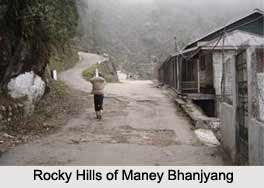 Maney Bhanjyang is a well known place in Darjeeling District. It is located at about 2150 meters from sea level.
Maney Bhanjyang is a well known place in Darjeeling District. It is located at about 2150 meters from sea level.
Location of Maney Bhanjyang
Maney Bhanjyang is a small transit-town in the Darjeeling Sadar subdivision, Darjeeling district in the state of West Bengal. It is located at the gateway of the Singalila National Park, 28 km away from Darjeeling town.
Geography of Maney Bhanjyang
Mane Bhanjang lies on the border between India and Nepal. The two countries are separated by a small culvert, which also acts as a motor stand for vehicles ferrying people to Sukhiapokhri and Darjeeling.
Economy of Maney Bhanjyang
The income of the local residents is geared towards tourism, especially foreign trekkers. Maney Bhanjyang is the start of the trailhead for the trek to Sandakphu on the Singalila Ridge, the highest point in West Bengal.
Culture of Maney Bhanjyang
Maney Bhanjyang has a renovated playground where a football tournament is organised in a very lustrous way every year during the Independence Day of India and from last 2 years, Mini Gold Cup has been organised by MBFA (Maney Bhanjyang Football Associated) which has grown up to be a huge success lately.
 Climate of Maney Bhanjyang
Climate of Maney Bhanjyang
Maney Bhanjyang is located at an average elevation of 1928 meters in the Darjeeling Himalayan Hill Region in the Singalila Ridge, the highest point in West Bengal. These hills are a part of the Mahabharata Range or Lesser Himalayan Mountain Range.
Landform of Maney Bhanjyang
The soil of Maney Bhanjyang is chiefly composed of sandstone and conglomerate formations, which are the solidified and up heaved detritus of the greater range of Himalaya. However, the soil is often poorly consolidated (the permeable sediments of the region do not retain water between rains) and is not considered suitable for agriculture.
Tourism of Maney Bhanjyang
Maney Bhanjyang is surrounded by several small villages and hamlets within a radius of 5-8 km. It attracts a large number of tourists for its villages and hilly towns.
Visiting Information
Maney Bhanjyang can be reached directly from New Jalpaiguri railway station where hired vehicles are available. Most vehicles are available from 4am to 6am. From Siliguri, shared and non-shared taxis operate directly for Mane Bhanjyang. One can also avail taxis from Siliguri and Darjeeling, which travel via Maney Bhanjyang.



















